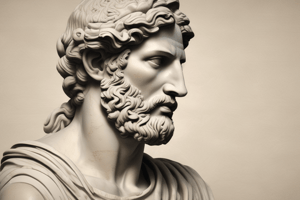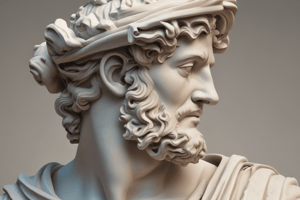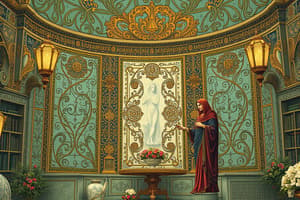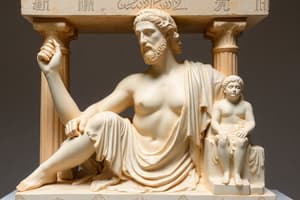Podcast
Questions and Answers
Egyptian sculptures were primarily created with what focus?
Egyptian sculptures were primarily created with what focus?
- Commemorating military victories
- Displaying the wealth of the pharaohs
- Religious purposes and the afterlife (correct)
- Depicting scenes from daily life
Which characteristic is most representative of Greek sculpture during the Classical period?
Which characteristic is most representative of Greek sculpture during the Classical period?
- Monumental scale and rigidity
- Exaggerated emotional expression
- Emphasis on human beauty and proportions, and naturalism (correct)
- Stylized, flat aesthetic
What distinguishes Roman sculptures from their Greek predecessors?
What distinguishes Roman sculptures from their Greek predecessors?
- Romans focused on realism, especially in portraiture and public monuments (correct)
- Romans used only bronze, while Greeks sculpted with marble
- Romans did not focus on religious themes.
- Romans avoided portraiture, believing it was vain
How did the Islamic faith influence sculpture within its cultural sphere?
How did the Islamic faith influence sculpture within its cultural sphere?
What design principles primarily defined Renaissance sculpture?
What design principles primarily defined Renaissance sculpture?
What characterizes Baroque sculpture, distinguishing it from Renaissance sculpture?
What characterizes Baroque sculpture, distinguishing it from Renaissance sculpture?
How did the Realist movement influence sculpture in the 19th century?
How did the Realist movement influence sculpture in the 19th century?
What distinguishes Cubism from other movements in early 20th-century sculpture?
What distinguishes Cubism from other movements in early 20th-century sculpture?
In what way did Surrealist sculptors challenge traditional artistic boundaries?
In what way did Surrealist sculptors challenge traditional artistic boundaries?
Which approach characterizes Minimalist sculpture?
Which approach characterizes Minimalist sculpture?
How does Pop Art, as seen in the sculptures of Claes Oldenburg, engage with contemporary culture?
How does Pop Art, as seen in the sculptures of Claes Oldenburg, engage with contemporary culture?
What is a defining characteristic of Pre-colonial Philippine sculpture?
What is a defining characteristic of Pre-colonial Philippine sculpture?
What influence did the Spanish Colonial Period have on sculpture in the Philippines?
What influence did the Spanish Colonial Period have on sculpture in the Philippines?
Which of the following characterizes sculpture during the American Colonial Period in the Philippines?
Which of the following characterizes sculpture during the American Colonial Period in the Philippines?
How does contemporary social commentary appear in current Philippine Sculpture?
How does contemporary social commentary appear in current Philippine Sculpture?
What key elements define Baroque churches in the Philippines during the Spanish Colonial era?
What key elements define Baroque churches in the Philippines during the Spanish Colonial era?
How did American architectural influence impact urban planning of Philippine cities during its colonial period?
How did American architectural influence impact urban planning of Philippine cities during its colonial period?
What best describes the function of a camera in photography?
What best describes the function of a camera in photography?
How did Dorothea Lange contribute to the field of photography?
How did Dorothea Lange contribute to the field of photography?
How have digital photography and mobile phones influenced modern photography?
How have digital photography and mobile phones influenced modern photography?
Flashcards
Egyptian Sculpture
Egyptian Sculpture
Sculpture primarily focused on religion and the afterlife; designed to house souls of the dead, featuring monumental scale and idealized forms.
Greek & Roman Sculpture
Greek & Roman Sculpture
Sculpture emphasizing human beauty, naturalism, and proportions; creating lifelike statues of gods, athletes, and philosophers.
Indian Sculpture
Indian Sculpture
Sculpture in Hindu, Buddhism, and Jain traditions that portray gods, goddesses, and religious stories. Deeply spiritual and narrative-based.
European Medieval Sculpture
European Medieval Sculpture
Signup and view all the flashcards
Byzantine Sculpture
Byzantine Sculpture
Signup and view all the flashcards
Islamic Sculpture
Islamic Sculpture
Signup and view all the flashcards
Renaissance Sculpture
Renaissance Sculpture
Signup and view all the flashcards
Baroque Sculpture
Baroque Sculpture
Signup and view all the flashcards
Neoclassical Sculpture
Neoclassical Sculpture
Signup and view all the flashcards
Realist Sculpture
Realist Sculpture
Signup and view all the flashcards
Cubism
Cubism
Signup and view all the flashcards
Surrealism
Surrealism
Signup and view all the flashcards
Abstract Expressionism
Abstract Expressionism
Signup and view all the flashcards
Minimalism
Minimalism
Signup and view all the flashcards
Pop Art Sculpture
Pop Art Sculpture
Signup and view all the flashcards
Environmental Sculpture
Environmental Sculpture
Signup and view all the flashcards
Installation Art
Installation Art
Signup and view all the flashcards
El Anatsui's Sculpture
El Anatsui's Sculpture
Signup and view all the flashcards
Mesopotamian Architecture
Mesopotamian Architecture
Signup and view all the flashcards
Egyptian Architecture
Egyptian Architecture
Signup and view all the flashcards
Study Notes
Sculptures in Ancient Civilizations
- Ancient sculptures were significant developments in global perspective.
Egyptian Sculpture (c. 3000-500 BCE)
- It was primarily religious and focused on the afterlife.
- The sculptures were designed to house the souls of the dead
- Examples include the Sphinx, Ramses II, and the Death Mask of Tutankhamun.
- Sculptures used monumental scale, rigidity, and idealized forms.
Greek & Roman Sculpture (c. 800 BCE-500 CE)
- Classical Greece emphasized human beauty and proportions through naturalism.
- Notable sculptors include Phidias, Myron, and Polykleitos.
- They created lifelike statues of gods, athletes, and philosophers.
- An example is the Discobolus (Discus Thrower).
- Romans adopted Greek styles, focusing more on realism, especially in portraiture and public monuments.
- Examples include Augustus of Prima Porta and Trajan’s Column.
Indian Sculpture (2000 BCE-500 CE)
- In Hindu, Buddhism, and Jain traditions, sculptures portrayed gods, goddesses, and religious stories.
- Example: Great Stupa at Sanchi, Stone Sculptures of Buddha.
- Deeply spiritual and narrative-based, influencing Asian art.
European Medieval Sculpture (c. 5th-15th Century)
- Religious themes were dominant.
- Gothic Cathedrals had intricate sculptures depicting Biblical scenes, saints, and gargoyles.
- Sculptures were symbolic and less concerned with naturalism.
- Example: The Superb Cathedral of Cologne.
Byzantine Sculpture
- Had Stylized, flat aesthetics with religious icons.
- Involved ivory and mosaic work.
- Example: Ivory Pyxis.
Islamic Sculpture
- Had Limited figural representation.
- Sculpture took the form of geometric and floral motifs in architectural decorations.
- Commonly found in palaces and mosques.
- Example: Alhambra in Spain.
Renaissance Sculpture (14th-16th Century)
- A revival of Classical ideas occurred, especially in Italy.
- Notable sculptors include Michelangelo (David, Pieta) and Donatello (St. George, David).
- Realism, anatomical precision, and humanist themes were reintroduced.
- There was a shift toward the individual as a central figure in art.
Baroque Sculpture (17th Century)
- There was integration of dynamism, movement, and drama, reflecting the grandeur of the Counter-Reformation.
- Gian Lorenzo Bernini (Ecstasy of St. Teresa, Apollo and Daphne) infused emotion and complexity into works.
Neoclassical Sculpture (19th Century)
- Revival of Greco-Roman ideals.
- Antonio Canova (Psyche Revived by Cupid’s Kiss) created calm, balanced, and idealized works inspired by ancient sculpture.
Realism (19th Century)
- Realist Movement (mid-19th Century) sought to depict life truthfully.
- Focus was more on ordinary people rather than mythological or heroic figures.
- Auguste Rodin (The Thinker, The Kiss) embraced a more rugged, emotional realism.
Cubism (20th Century)
- Influenced by Pablo Picasso & Georges Braque.
- Deconstructed objects into geometric forms.
Surrealism
- Sought to explore the unconscious mind, creating abstract or dream-like forms.
- Seen in Giacometti’s elongated, ghostly figures.
- Example: Alberto Giacometti’s Toward the Ultimate.
Abstract Expressionism
- David Smith & Alexander Calder contributed work to this style.
- Boundaries were pushed with abstract, non-representational works.
- Calder is known for mobile sculptures, which introduced movement into sculptures.
- Example: David Smith’s Field Work.
Minimalism (Late 20th Century-Present)
- Donald Judd & Carl Andre contributed work to this style.
- Sculpture was reduced to its most basic forms and materials, stripping away emotion and narrative.
- Example: Donald Judd’s Laumeier Sculpture Park.
Pop Art
- Claes Oldenburg created playful, oversized sculptures of everyday objects, blending high and low culture.
- Example: Claes Oldenburg’s The Everyday Made Extraordinary.
Environmental and Sculpture and Land Art
- Richard Serra & Robert Smithson contributed work to this style.
- Monumental works were set within natural environments.
- Example: Smithson’s Spiral Jetty (1970) used Earth’s rocks to sculpt the landscape itself.
Installation Art
- Anish Kapoor, Louis Bourgeois, & Ai Weiwei contributed work to this style.
- Immersive, large-scale works interact with the environment and audience.
Contemporary Sculpture
- Has become more fluid, reflecting diverse cultural narratives.
- Yinka Shonibare explores post-colonial identity through the use of Dutch wax fabrics in his figures
- Example: Suspended States - Serpentine Galleries
- El Anatsui from Ghana uses recycled materials, such as bottle caps, to create monumental sculptures, blurring the line between art and craft.
- Indian contemporary artists like Subodh Gupta utilize everyday objects, such as steel kitchen utensils, in monumental installations reflecting modern Indian life.
Technology in Sculpture
- Artists now use 3D printing, virtual reality, and interactive media to push the boundaries of the medium.
Development of Sculpture in the Philippines
- It is a rich and diverse journey shaped by indigenous traditions, colonial influences, and modernist movements.
- It reflects the complex socio-cultural history of the Philippines, from its pre-colonial roots to contemporary times.
Pre-colonial Period (Before 16th Century)
- Primarily for religious and practical purposes.
- Artworks were often animistic in nature and served as ritual objects or household items.
- Key materials used included wood, stone, and metals.
- Bulul: Wooden carved deities, believed to guard rice harvests
- In the Northern Cordillera Region, it was made by the Ifugao people.
- Manunggul Jar: A burial jar found in Palawan with a carved boat on its lid, representing the soul's journey to the afterlife.
- Okir
- In the southern Philippines, particularly among the Maranao and Tausug.
- Floral and Geometric designs.
- Used in wood and metal carvings for house posts, boats, and weapon handles.
Spanish Colonial Period (16th-19th Century)
- Heavily influenced by Christian Iconography.
- Spanish friars commissioned local artisans to create religious statues for churches and homes.
- Blend of Native craftsmanship and European style.
- Santos (Religious Icons).
- The most prominent sculptures during this period.
- Wooden images of saints, the Virgin Mary, and Jesus Christ.
- Often elaborately carved and painted, sometimes decorated with gold leaf.
- Ivory Carvings
- Influenced by both Spanish Catholicism and Chinese ivory artistry due to the Manila-Acapulco Galleon Trade.
American Colonial Period (Early 20th Century)
- A shift in focus toward secular and public art occurred.
Nationalism in Sculpture
- Expressed nationalism.
- Filipino artists started adopting Western academic styles.
- Guillermo Tolentino, one of the foremost Filipino sculptors, emerged during this time.
- Bonifacio Monument (1933): A tribute to the revolutionary leader Andres Bonifacio.
- Oblation (1935): A symbol of academic freedom for the University of the Philippines.
- Marked the rise of Filipino identity in sculpture, blending realism and romanticism with themes of independence, history, and national pride.
Post-War & Modern Period (1940s-1970s)
- Rose of modernist movements.
- Artists began experimenting with abstract forms and a variety of new materials.
- Influenced by global trends while expressing local themes.
- Napoleon Abueva: The father of modern Philippine sculpture.
- Pushed the boundaries of traditional sculpture by using new materials such as metal, hardwood, marble, and brass.
- Works combined traditional Filipino subjects with modernist aesthetics.
Public and Monumental Sculptures (Contemporary Period)
- Created with large-scale public sculptures, including monuments and memorials.
- Often reflecting the country’s struggles and aspirations for independence and nation-building.
- Allegorical Harpoon.
- Nine Muses.
- The contemporary period is characterized by a diversity of styles and materials, ranging from traditional to conceptual art.
Contemporary Themes in Sculpture
- Sculptors often address contemporary social issues, such as poverty, political corruption, and environmental degradation, while continuing to explore personal, historical, and cultural themes.
Mixed Media in Sculpture
- Many contemporary sculptors experiment with a variety of media—including found objects, mixed materials, and even multimedia.
- Artists such as Imelda Cajipe-Endaya and BenCab (Benedicto Cabrera) contributed to the blending of sculpture with social commentary and installation art.
Public Art and Installations
- Reflect both historical events (like Eduardo Castrillo's People Power Monument) and contemporary issues.
- Contemporary artists such as Leeroy New have gained attention for creating highly imaginative and avant-garde installations that fuse sculpture with architecture, fashion, and design.
Architecture
- Architecture reflects a country's lifestyle, cultures, traditions, motives, and beliefs.
Mesopotamian Architecture
- Was characterized by ziggurats, large stepped pyramids that served as temples.
- Sumerians, Akkadians, Babylonians, and Assyrians built these structures, demonstrating the power of their gods.
- Ziggurats were built at successive levels with one hump leading from one platform to the next.
- Hanging Garden of Babylon.
Egyptian Architecture
- Dependence was on religion.
- Egyptians belived that "Ka"/"vital forces" live in every human being.
- To preserve the vital forces in the body, they built pyramids together with temples
- Designed to reflect the divine power of pharaohs and were heavily influenced by religious beliefs.
- Pyramids of Giza.
- Pyramids of Khufu.
Greek Architecture (600-100 B.C.)
- Was Famous for its development of the (3) architectural orders: Doric, Ionic and Corinthian
- A lot of Temples, theaters, and stoas are typical Greek architectural elements.
- Used relatively small rectangular plans of marble with a entablature and made the building from an architrave, cornice, and frieze,.
- Parthenon Temple.
- Arte
Studying That Suits You
Use AI to generate personalized quizzes and flashcards to suit your learning preferences.




